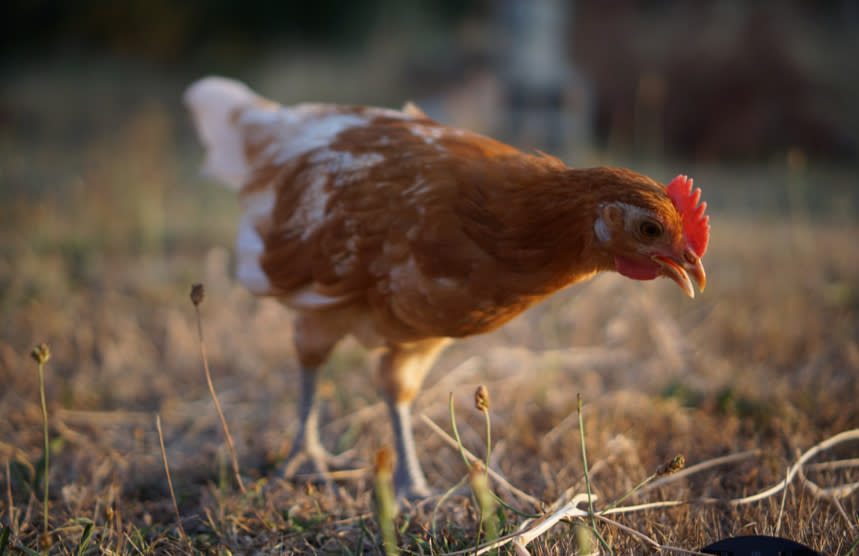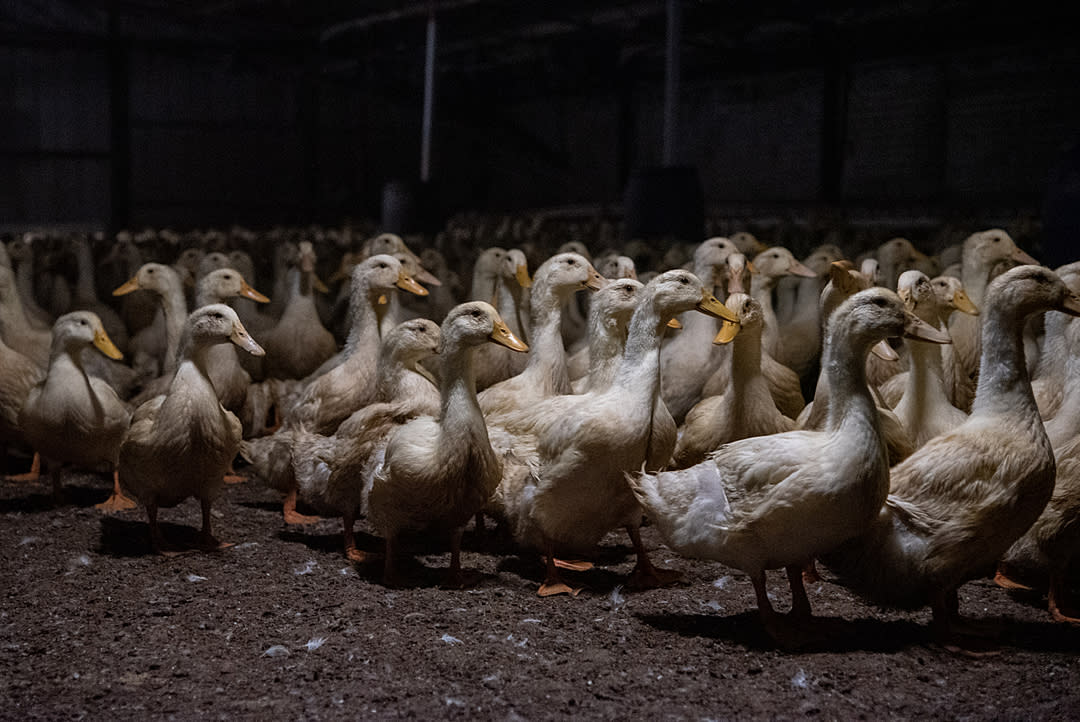




The majority of chickens don't get to live out their full, natural lifespans. Instead, the factory farm industry cuts their lives short.

Chickens are gentle, intelligent birds. They love to spend their days foraging in the grass for insects and seeds, taking dust baths to keep themselves clean, and creating and protecting nests when they become doting parents. But the majority of chickens don’t get to live this natural and happy life. The majority of these sweet animals are used and abused for profit, their natural lifespans cut short by injury, disease and slaughter.
How long do chickens live in the wild?
The chickens we commonly see depicted in advertisements or on packaging in our supermarkets represent only a handful of the chicken breeds in the world. There are hundreds of different breeds of chickens around the world—so many that the real number isn't even known!
Because of this immense diversity, it's difficult to say how long chickens live on average. Generally, most wild chicken breeds can enjoy lifespans between three and seven years, and sometimes longer. Despite the challenges of living in the wild, including the risk of predators, wild chickens have longer lifespans than domestic chickens. What's more, these lucky individuals get to roam free in the great outdoors, spend time with their families and friends, and raise their young themselves.
This life of freedom is far different from what the majority of chickens experience.
How long do backyard chickens live?
Some people choose to adopt or rescue chickens from the egg industry, keeping them in their homes as companions. If a family provides their chickens with adequate care—including high-quality food, shelter from bad weather (typically in the form of a coop or fence), protection from outside predators, and regular veterinary checks—chickens can live much longer than they would in a factory farm. Some backyard chickens live a decade or more.
What do chickens usually die from?
In the United States, billions of chickens are bred, raised, and killed every year. Virtually none of them are wild, and a very small percentage of the chickens are in backyard flocks. The vast majority are kept on intensive agriculture operations known as factory farms, where they are raised and slaughtered for eggs or meat.
This means that the number one cause of death for chickens in the US is, unquestionably, slaughter at the hands of humans.
How long do chickens live before slaughter?
The US food industry uses chickens for two products: eggs (that come from egg-laying hens) and meat (which come from chickens raised specifically for meat, known as broiler chickens). What they are used for affects how long they live, although both egg-laying hens and broiler chickens who are raised for meat face abnormally shortened lifespans. Layer hens live to be about 18 to 24 months old before the industry considers them "spent"—unable to lay more eggs—and sends them to slaughter. Broiler chickens live to be about 47 days old before they meet their violent end, risking being boiled alive through a cruel slaughter method known as "live-shackle slaughter."
What factors affect a chicken's lifespan?
A factory-farmed chicken begins their life in a sterile hatchery, where they emerge from their egg along with thousands of other chicks. Many of these chicks will go on to experience a brief, misery-filled life—but for some chicks, life is about to come to an abrupt, horrifying end even sooner.
Gender
Broiler chicks of both sexes will live to be the same age since both genders are used to make breasts, nuggets, and the multitude of other chicken products eaten by Americans.
In egg production, however, there is a huge difference when it comes to the lifespan of male and female chicks. Since males are unable to produce eggs that companies can profit off of, they are considered entirely useless by the egg industry.
Shortly after they hatch—often when they are only a few hours old—male chicks are sorted apart from female chicks and killed in some of the most horrific ways imaginable during a process known as "chick culling." The male chicks are sent down a conveyor belt that leads them to a macerating machine, which grinds them alive. Some facilities gas the chicks to death, while others may choose to cram chicks into huge plastic bags where they will be crushed to death or suffocated.
For male chicks on egg factory farms, life amounts to only a few short, and brutal, hours.
Housing
For those chicks who make it past the hatchery, a life of misery awaits. Many commercial egg farms stuff layer hens into cages so small, that they don't allow birds to fully stretch out their wings. Known as battery cages, this intensive form of confinement forces hens to live out most of their lives in a space that is roughly the size of a sheet of paper. Hens can't follow any of their natural instincts, meaning that they are never able to dig in the earth, peck at the ground, perch, or make nests.
Broiler barns are not much better. They are often overcrowded, preventing birds from being able to walk around, and leading to muscle and skeletal conditions that can be fatal. These farms also force chickens to live on the ground that is covered with their own excrement. These filthy environments can be fatal to birds, with risks coming from bacteria growth as well as ammonia from the feces that can cause respiratory issues.
Breed
Breed plays a big role in shortening the lifespans of chickens on both egg and meat factory farms.
The meat industry selectively breeds broiler chickens to grow much faster than they ordinarily would. Their bodies grow much more muscle than nature intended, all so the industry can produce more meat to sell. Known as "rapid growth" breeds, these chickens are so prone to skeletal and other health problems that they would soon die even if they weren't slaughtered at about six weeks of age.
On the other hand, the egg industry breeds layer hens so that they produce extremely high volumes of eggs—about one per day—versus the roughly twelve or so per year that wild chickens might produce. This demand on hens' bodies can cause horrifically painful conditions including drooping organs known as prolapses, calcium depletion that can lead to broken bones, and ovarian cancer.
Disease
In the wild, chickens regularly encounter pathogens that can make them sick. But on factory farms, the conditions are so filthy that disease is essentially a given. This is why chicken farms tend to liberally give antibiotic treatments to chickens as a preventative measure. The overuse of antibiotics in factory farms doesn't just have health implications for chickens—it also contributes to the development of antibiotic-resistant pathogens that can spread to humans and threaten public health.
Diseases, including cancer, Mycoplasma gallisepticum, and Blackhead and Marek's diseases, can all pose serious health risks to chickens and contribute to shorter lifespans. But why is disease so common in chickens raised for food?
Factory farms prevent chickens from enjoying the great outdoors and fresh air, and these densely packed indoor sheds deny them the ability to perch, fly, or socialize as they would naturally. As a result, chickens can become chronically stressed, which in turn depresses their immune systems' ability to fight off disease. This is especially problematic when we see that factory farm environments are riddled with feces, providing an ideal breeding ground for viruses and bacteria.
These factors—coupled with the fact that chickens are forced to produce more eggs and meat than is even close to natural—clearly indicate why chickens can be so afflicted with illness.
Veterinary Care
Veterinary care should be administered to any farmed animal who is suffering. But on chicken factory farms, where often hundreds of thousands of birds are confined together, there are simply not enough vets to go around and deliver necessary care.
The number of animals on factory farms makes it difficult, if not impossible, for farmworkers to even observe instances of illness in the first place. As a result, medical treatment often doesn't arrive, leaving chickens to die and rot in their cages or barns.
Slaughter
Slaughter is the number one factor affecting the lifespans of chickens, be it on egg or meat factory farms.
Nearly all chickens wind up at the same slaughterhouses and receive the same devastating treatment. The industry-standard method of slaughter, known as live-shackle slaughter, often does not properly stun chickens before slitting their throats and throwing them into a vat of boiling water, causing excruciating agony to chickens who have been abused their entire lives.
Which chicken holds the world record for the longest life span?
As you can probably guess, the record for the world's oldest chicken did not come from a factory farm. Matilda was an Old English Game breed kept as a companion bird and lived to the remarkable age of 16. She never produced any eggs, which may have contributed to her long lifespan.
Compare Matilda's long life with the two-year lifespan of a layer hen, or the under two-month lifespan of a broiler chicken, and the cruelty of these industries becomes all the more obvious.
What can you do?
Chickens deserve better than the short, miserable lives that the egg and meat industries give them. Join us to tell some of the world's biggest corporations it's time they end the worst abuses that chickens endure on factory farms.






